
Admin News
Week Without Walls (WWW)
It was wonderful to see the enjoyment from our students as they participated in “outside classroom walls” learning activities this week for our annual Week Without Walls. Having to go virtual was a challenge, but congratulations are in order to the faculty for planning activities that engaged students in thoughtful activities, and to our students who contributed through their participation.
The philosophy behind CIS having WWW is centered on our belief in the importance of experiential, constructivist learning, and the explicit development of a wide range of skills and attributes identified as Approaches to Learning (ATL) and Learner Profile (LP) attributes. We believe providing an extended period of time outside the classroom to engage in purposefully planned activities enables our students to develop many of these skills and attributes in ways that are not possible or are more difficult, in a classroom setting.

All of our WWW activities were designed around the promotion of one or more of the following areas: creativity, activity/action, service learning and/or intercultural/international mindedness. In addition, interdisciplinary/curriculum links were explored when the opportunity presented. Service learning has been designated as a particular focus for CIS, therefore aspects of Service Learning were included in all WWW activities so as to contribute towards our Service Learning objectives as well. Please enjoy the reports below from the various WWW activities!
CIS Parent Coffee
It was great to chat with parents at our CIS Parent Coffee this past Wednesday morning. The PTA ran this meeting and we discussed fundraising activities such as online bazaars, and shared various aspects of Social Emotional Learning that we apply to ourselves. It was a nice relaxing meeting, and we encourage more parents to join next time to get the benefit of community support from the PTA!
*Save the date: Our next Parent Coffee meeting will be on March 24 (Wed) at 9am.
Please note, next week Feb 24-26th is a school holiday.
FYI, our faculty will be spending two of these three days on professional development (PD) after our November PD days were rescheduled to cater to our IB MYP workshop.
Have a wonderful weekend.
Regards,
Dr. Gwyn Underwood,
Superintendent
Elementary News
by Mr. Glenn Davies, Elementary School Principal
Dear Elementary Community
Each year during mid February Cebu International School hosts the annual Week Without Walls (WWW) event. This is a week when increased focus is placed upon Service Learning (SL) and Outdoor Education. Like many concepts, there are a number of definitions for Service learning, however, the core intention of SL is to help students develop deeper levels of empathy for others who do not have access to the privileges and benefits we may have access to. Remote Learning has again required our teachers to rethink the way they design these Service Learning experiences for students. To help guide the Week Without Walls events, the Elementary Teachers developed a WWW Playbook, where the four pillars of Curriculum, Service, Outdoor Education, Creativity guided their decisions and plans. Each experience the teachers designed were considered in light of these four concepts;
Curriculum
Where possible connections are made to the Units of Inquiry being focused on during the school year.
Service
CIS aims to be involved in sustainable service projects and avoid temporary efforts that enable us to feel good. At the elementary level we acknowledge this can be more challenging to achieve, so where possible we work with existing partners to continue relationships we may already have, or have used in previous years. We also acknowledge that the focus of these service projects are to change the way our students view the world and to develop within them greater levels of empathy and care.
Outdoor Education
While carefully managing and minimizing risk factors, we aim to provide students with a range of ‘challenge by choice’ activities where they may extend their own levels of self-efficacy, physical skill, and self-management.
Creativity
We aim to ensure students are actively involved in meaningful problem finding and problem solving experiences that are memorable, highly engaging and become a reference point for future challenges that emerge in their lives.
Again I am incredibly proud of what our teachers have been able to design and implement, while also being incredibly proud of how your children, our students, have engaged and responded to these experiences and challenges. Please continue reading below, to learn more about the WWW experiences students have been engaging with during the past week.
Early Years 2/3 Week Without Walls
Our youngest learners participated in a range of experiences that focused on supporting the UN Sustainable Goal #3 – Good Health and Well-being, in order to extend their understanding of the five senses. During the Design Day on Tuesday our young designers created an invention to protect their ears from loud and unpleasant sounds. During Thursday’s Design Day, students invented a way to protect their skin from different kinds of weather. With support from you, the adults at home, they were able to produce creative and innovative designs which they proudly shared with their friends.

In order to show appreciation to the members of their household who care and help them each day, the Early Years students learned how to provide some kind services to their family members, such as massages, foot spas, pleasant lullabies, eye exercise, and relaxation techniques. This opportunity helped students to understand the concept of serving others. The EY 2/3s culminated the WWW with a virtual tour led by Coach Jay, that included some physical challenges and virtual sightseeing. To conclude WWW, students had a virtual picnic and prepared their own sandwiches that required them to make use of their five senses.

Kinder and Grade 1 Tamaraws
 In connection to the UN Sustainable Goals specifically SDG No. 4 – Quality Education, the Kinder and Grade 1 students designed and created their very own word and number games. Then for SDG No.6 – Clean Water and Sanitation, students designed and built marble runs. Each morning this week, the students shared their designs and gave feedback to one another to improve their designs. By the end of each day, the students were able to make changes and modifications to their designs. This involved adjusting the rules in their games, and re-building their marble runs so the water/marble flowed more smoothly.
In connection to the UN Sustainable Goals specifically SDG No. 4 – Quality Education, the Kinder and Grade 1 students designed and created their very own word and number games. Then for SDG No.6 – Clean Water and Sanitation, students designed and built marble runs. Each morning this week, the students shared their designs and gave feedback to one another to improve their designs. By the end of each day, the students were able to make changes and modifications to their designs. This involved adjusting the rules in their games, and re-building their marble runs so the water/marble flowed more smoothly.
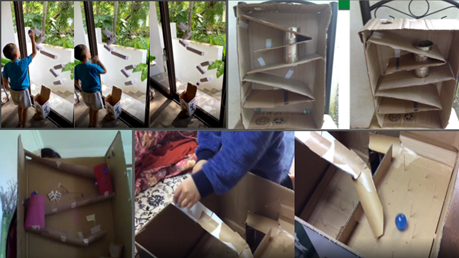 In line with the United Nations Sustainable Goals #4 of ‘Quality Education’, the KG/G1 students designed a board game for someone else to play. Their board game was created to teach a specific skill (i.e literacy or number skill).
In line with the United Nations Sustainable Goals #4 of ‘Quality Education’, the KG/G1 students designed a board game for someone else to play. Their board game was created to teach a specific skill (i.e literacy or number skill).
To make connections to the UN Goal #6, ‘Clean Water and Sanitation’, the KG1 students made their own marble run. The marble could represent the water. They find ways and ensure that the water can flow smoothly to all areas of a town or city.
Grade 2-3 Week Without Walls: Camp Chronos
The Grades 2 and 3 students have been focusing on SDG 10: Reduced Inequalities. On Day 1 of Week Without Walls, students connected with and built on their current unit of inquiry (Where We Are in Place and Time) by exploring inequalities in the past. Having already learned about the Civil Rights Movement and disability rights, they turned their focus to material resources. Time-traveling back to the early 1940s, they realized that factories had stopped producing toys during WWII and few families had money to spare. How they dearly missed their favorite toys and games from 2021! Looking to then make their own toys and games, they realized that materials like rubber, metal, and wood were also scarce… and plastic would not be common for another 10-20 years! The students showed their creativity and perseverance by designing working toys and games with limited resources and showed how they can respond to challenges.

On Day 2 of WWW, the Grades 2 and 3 students then traveled back to 2021 and participated in a total of 10 hands-on, experiential learning activities to experience a range of inequalities that people still face around the world today. They carried water containers on their heads through treacherous roads, washed and hung their own laundry, and felt indignant about receiving unequal pay for their hard work. They connected these experiences to poverty (SDG 1), unequal access to quality education (SDG 4), and gender inequality (SDG 5). They learned about the global food crisis (SDG 2), as well as wars, disasters, and discrimination that make places unsafe for people to live in different areas (SDG 16). Given just five minutes to pack their bags and flee their homes to take on perilous journeys, they also reflected on how difficult and life-changing this experience would be for refugees, who often also face additional challenges post-settlement.

At the time of writing, the students are in the midst of their second design challenge for Day 3 of WWW to create and innovate products in response to these challenges. They are also drawing connections between SDG 10 and the other SDGs, coming to the realization that the SDGs are crucially interconnected. Tomorrow, they will bring everything together and explore how other people have innovated in response to significant events and challenges through history. We look forward to reflecting on our experiences together! WWW has been a fantastic opportunity for students to gain insight, develop empathy, exercise their creative thinking skills, demonstrate persistence, and build on their social relationships. Well done, Grades 2 and 3!

Grades 4 and 5 @ Week Without Walls

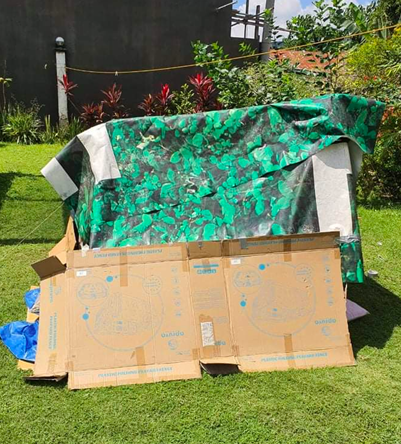
Grade 4 and 5 students started the week by each planning their own schedule for a “Quality Education” tech-free day. This was aligned to the UN’s Sustainable Development Goal #4 – ‘Quality Education’. This provided students with the challenge that communication technology, such as cellphones, tablets, iPads or computers would not be available to them. It posed some challenges, but they were able to pull through with it.
During the week, the students were able to learn from a primary information source, a guest speaker who shared her experience about being a refugee from Zimbabwe. The students were enthralled with Ms. Kim’s story, and her experience of leaving home with virtually nothing, including no money, and having to start all over again. They were able to compare and contrast this with our second speaker, a refugee from Vietnam.
The students also designed and built their own shelter to simulate the experience of being in a refugee camp. They were able to use different materials, and had to test and modify their structures to ensure they were durable. The shelter should be waterproof, windproof, and ‘earthquake’ proof. They also made their own meals for the day. Everyone had a memorable and meaningful experience by creating, building, and some even choosing sleeping in their shelter. They were excited to make their own meals. We culminated the day with a combined Grade 4/5 Talent Show on Thursday night.
Middle and High School News
by Mr. Dale Wood, Middle and High School Principal
This week our students have all been involved in a range of WWW courses carefully engineered and implemented by their teachers. As I have stopped by on virtual visits this week, it has been heartening and wonderful to witness our students both having a good time and learning. Lots of smiles and laughter! I want to give a sincere and hearty shout out to our teachers for taking on a challenging situation (virtual WWW) and making it excellent, engaging, and enjoyable! Next week we will have reports from each group as to our students’ experience and learning.
Just to whet your appetite, here is an glimpse into what one of our groups have been doing this week:
WWW Update from the Educators of the Galaxy Team
This week members of our team have been working together to create online lessons or video tutorials in the areas of Mandarin, Spanish, Arts and Science which can be shared and made available to those unable to physically attend school. These videos represent the students’ unique contribution to the community, particularly in promoting the need to continue learning despite the pandemic.
Day 1 of the Week Without Walls was quite busy. A significant amount of time was allotted for the planning of the flow for the lesson or tutorial, to research, and to practice. The students gathered in their respective subject area groups to be able to work closely together and receive guidance and support from the respective teachers.
Day 2 started with a close collaboration session for the members in their respective subject teams. Work in the morning was focused on developing the videos based on the outlines/plans students had prepared.
A whole group feedback session was conducted in the afternoon. Some students were asked to present their plans and current videos. It was great to hear affirmation and constructive feedback from the members of the other subject area groups. However, we also recognized a great deal of work that would still be needed for the completion of high-quality instructional videos. As the students returned to their respective subject groups, they brought with them the commitment to deliver the expectations.
MHS Chinese New Year Celebration
新年快乐!牛年大吉!Happy Chinese Lunar Year!
 Chinese New Year is a traditional festival which celebrates the start of the new year according to the Lunar Calendar. The whole celebration starts from the days leading up to the New Year, from the 15th of the January of the Lunar calendar. Every year the date of the new year changes and this year February 12 was the 2021 date for the Chinese Lunar New Year. To celebrate the Year of the Ox our MHS Mandarin students prepared some performances and hosted the virtual Chinese New Year Assembly which took place on Monday, February 15.
Chinese New Year is a traditional festival which celebrates the start of the new year according to the Lunar Calendar. The whole celebration starts from the days leading up to the New Year, from the 15th of the January of the Lunar calendar. Every year the date of the new year changes and this year February 12 was the 2021 date for the Chinese Lunar New Year. To celebrate the Year of the Ox our MHS Mandarin students prepared some performances and hosted the virtual Chinese New Year Assembly which took place on Monday, February 15.
In the virtual Chinese New Year assembly, Grade 8 and 9 students wrote and narrated the story of Monster Nian in English and Chinese, and made a video telling the story to explain why Chinese people celebrate the New Year and how people celebrate the event. Grade 6 and 7 students introduced items related to the Chinese New Year celebration, such as fireworks and spring couplets. They introduced these items and explained how they are related to the New Year celebration. Grade 11 Mandarin students sent a lot of New Year’s wishes with the allegro instrument playing as the background music. To celebrate the year of Ox, Grade 10 students performed a song called An Ox (一头牛) to bring the wishes of hope that everyone would have a healthy and lucky new year. As an ending, all the MHS students sent out a lot of new year wishes as class.
Here are some photos from our assembly video.
 Besides preparing for the New Year performances, the Mandarin students also experienced different activities during our class time. Grade 6/7 students watched a few videos, such as the Legend of Monster Nian, Sui story, and 12 Zodiac signs animal stories. They have learned the celebration activities and the cultural explanations for the ways people celebrate. For example, why do Chinese people like to have fish for New Year’s Eve dinner? Why Chinese people hang red decorations in the house for the New Year? Why Chinese people have fireworks during the New Year? Students also tried to make some handcraft, such as card holders, bouncing caw, new year cards, and ox lanterns. Grade 8/9 students also watched a few videos to learn more details about Chinese New Year celebrations and tried out different handicrafts during the class call, such as ox lanterns, ox heads, and cow lollipop holders. Grade 10 students learned about New Year information through a lot of activities and made their own handicrafts as well, including paper cutting, ox lanterns, ox heads, and bouncing ox. Grade 11 and Grade 12 Mandarin B students celebrated the new year by making some paper cuttings, ox cards, and New Year’s flowers. Besides this they also watched a few videos and learned how the Chinese New Year is celebrated. The students explained the celebration activities orally and discussed their own experiences of the holidays.
Besides preparing for the New Year performances, the Mandarin students also experienced different activities during our class time. Grade 6/7 students watched a few videos, such as the Legend of Monster Nian, Sui story, and 12 Zodiac signs animal stories. They have learned the celebration activities and the cultural explanations for the ways people celebrate. For example, why do Chinese people like to have fish for New Year’s Eve dinner? Why Chinese people hang red decorations in the house for the New Year? Why Chinese people have fireworks during the New Year? Students also tried to make some handcraft, such as card holders, bouncing caw, new year cards, and ox lanterns. Grade 8/9 students also watched a few videos to learn more details about Chinese New Year celebrations and tried out different handicrafts during the class call, such as ox lanterns, ox heads, and cow lollipop holders. Grade 10 students learned about New Year information through a lot of activities and made their own handicrafts as well, including paper cutting, ox lanterns, ox heads, and bouncing ox. Grade 11 and Grade 12 Mandarin B students celebrated the new year by making some paper cuttings, ox cards, and New Year’s flowers. Besides this they also watched a few videos and learned how the Chinese New Year is celebrated. The students explained the celebration activities orally and discussed their own experiences of the holidays.
Grade 11 ab initio students celebrated the Lunar New Year with a Kahoot quiz game during the synchronous call, learning some basic knowledge about Chinese New Year. During the asynchronous session they chose different activities from the choice board to complete the Chinese New Year activities. These activities included paper cutting, fortune bag origami, dumpling making, paper doll ox making, and red envelope making. The activities will help the students to gain a basic understanding of the traditional items that are used during the Chinese New Year. Over the weekend Grade 11 and Grade 12 watched the documentary A Bite of China: Celebrating Chinese New Year (舌尖上的新年)to learn more about how Chinese people prepare traditional foods in celebration. Overall, students were able to appreciate and understand what this special event means within the Chinese culture.
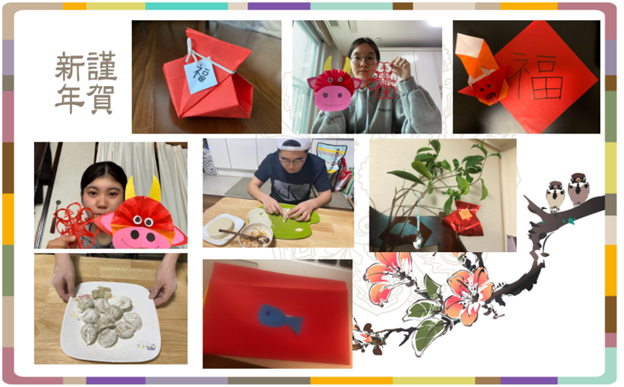
As Week Without Walls officially began on Tuesday, we did follow our regular school schedule and conducted our regular classes on Monday. Please find some of the classroom activities we have seen over the previous weeks in MHS.
Grade 9 Design Class
by Ms. Gerri Ancajas Jumao-as, Design Teacher
The Grade 9 Design class are currently busy exploring techniques and developing skills related to textiles through a series of formative exercises. The following weaving exercise, involved two sets of yarns or threads that are interlaced at right angles to form a fabric or cloth.
Here are some examples of our students’ work and reflection:
The spacing needs to be more consistent so there are no gaps in between. Tension could also be improved so it does not look too loose. – Minseong

Overall, I did well on this task. I was prepared with the materials we needed and I managed time wisely while working. The finished product turned out okay; some parts where the thread ended and I needed to get a new piece look a bit messy, but the weaving is mostly pretty neat. Tying the loose ends when I finished weaving was a bit tricky, because I made the columns differently so the ends were pretty short. However, I was able to tie them, and it turned out fine. – Mahati
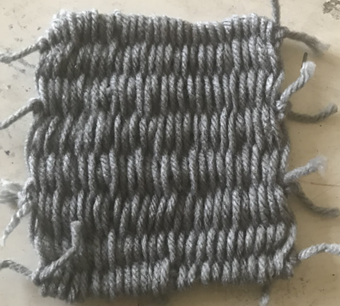
In this task I did pretty well. I managed not to make the weave too tight or too loose which is good. I also used different colors to make the weave look more interesting, rather than just using one color to make it look boring. – Liam
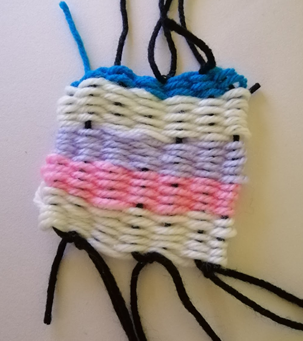
I think that I did ok for my first time, definitely need some improvement but overall for me I think its ok. – Clark

Students also used problem solving strategies and sewing skills in our exercise focused on repairing a tear in fabric This exercise involved mending of cuts or tears in clothes.
I would say that my performance in this task was pretty messy- not the best it could be. Though I think my performance was passable in repairing the tear.- Sofia
Overall, I’m really happy with my final product and I think that I did well considering that I’ve never sewn before or seen anybody do it close up. My feedback for this task was also pretty good. The feedback I received is that I did a good job closing up the fabric stitches at the end of the tear and I also was able to make my stitches close enough and not too far away from each other. Overall, it looks good but next time I can keep the same distance of thread apart from each other on both sides and make them look more even and balanced. – Esther

The feedback I received is that I need to practice before I actually start on proper clothing. The stitch is messy and very obvious. I need to improve on spacing and general technique, as the space between the thread is large, and they are tight in some areas but loose in others. – Zeke

The final product turned out good. I could have made my stitches a little neater, and I may have pulled the thread to bring together the fabric a little too tightly. I was careful sewing the stitches, making sure I didn’t pull too much while stitching, and trying to be as even as possible. The feedback I got for this task was pretty good. My stitches were pretty even, but I could have left more room before sewing on the tear and making the stitches a bit thinner, because the fabric still bunched up at the ends. – Mahati

Lastly, students engaged in an exercise focused on patching a hole. This exercise involves using a patch of cloth to repair a piece of clothing that has a hole in it, in order to protect it from further damage or to decorate the article.
I did a good job of managing the tightness of the stitching. The stitching looks neat but I think I should have made the gap between each stitching the same so that it looks nicer. – Liam

Overall, I think I performed this task well. I didn’t make my stitching too loose, and I followed the patching process correctly. I also pulled my knots correctly and tight enough at the end of this task. I was able to push the pins into the patch without them getting in the way of my stitching. One of my classmates gave me feedback. She said that the consistency of my stitching at the top of my patch was consistent, but that next time I could make my stitches a little neater, straighter and closer together. Based on this feedback, next time I can make my stitches neater and not pull the fabric together as tightly as I did for this task. – Esther

I think I have been improving my abilities in stitching. My work is neater than before and there are far less wrinkles in the cloth. I have also grown more confident and am able to work faster, while also creating fewer knots. – Sofia

I think I did well in this task. My stitching was mostly good; they were done correctly. My end knot was a little messy, but it still worked ok. The edges of the patch frayed a little, so next time I use this method, it would be better to use a circle so it doesn’t fray as much. I received feedback from my classmate. She also said that the stitching was okay, but it could be a little neater and more consistent. If I were to patch something in the future, I would try to make my stitches smaller and neater, and I would also use a different shape for the patch. – Mahati

Finally, students learned through an exercise focused on adding buttons to a piece of fabric This exercise involves sewing buttons to clothes either as a fastener or decoration.
Overall, I did the adding button part well. I got confused on the first button, but I finished it well and I did the second (black) button well. Actually, this exercise was the easiest exercise that we have done. – Minseong

Personally I think that, while the button is secure, the stitching at the back was pretty messy and all over the place. I think that next time I should try and keep better track of where the needle is going and where the thread is on the back, rather than just pushing the needle through the underside of the cloth. – Zeke

I think that my sewing looks pretty good for it being my first time sewing a button on. I will say that compared to my other formative tasks, this is the one that was the easiest to complete since the instructions were pretty straight forward. I still think I can improve on making it look cleaner since the back looks like I pulled too hard and there is some extra string on the top and the bottom which would not look good if it was on an actual shirt. – Natalie

The session, I would say, went well. I would say that I did good but I do need to improve some since on the first one I was kinda confused because the youtube video was pretty fast for me. But I would say that I did well. – Clark

Grade 10 Biology
In the subject of Science, our Grade 10 Biology students have been studying the structure of DNA, replication of DNA, Mitosis, and the events of Meiotic cell division that results in the formation of unique gametes.
To understand the process of DNA replication, incorporating the related concept of using patterns and models, students used different materials that are in their houses, such as clothes pegs, gummy bears, lids of markers, etc.
Parent strands of DNA
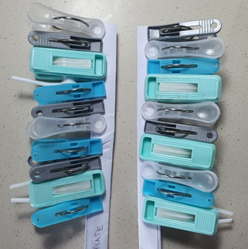
Parent strands used as a template

Replicated DNA molecules

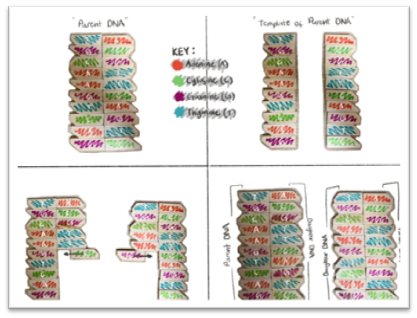

Students groups also enthusiastically took part in a Jamboard activity drawing the various stages of Meiosis. They were also able to compare the differences between Mitosis and Meiosis. Also, they understood the mechanisms in Meiosis that give rise to variations among the species.
Grade 11 DP Biology
Grade 11 DP Biology students are engaged in the unit on Genetics.
In small groups, they used Jamboard to trace the effects of dominant and recessive alleles.

As a formative assessment before a mid-unit summative test, they took part in a Kahoot game.
Grade 12 DP Biology
Grade 12 DP Biology students have completed their Internal Assessment task. Several students had to adapt their original laboratory based plan to fit into a home based one. Some of them had to completely change their IA topics and did interesting simulation based investigations.
Muscle Development (simulation)
Phytohormones (home based)
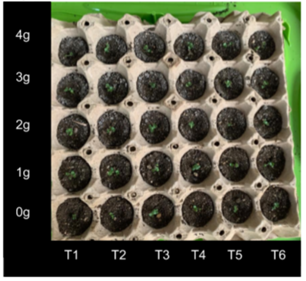
Hydroponic cultivation system (home based)
Moss in the mitigation of soil pH (Home based)
Grade 6 and 7 Science
ADAPTATION refers to the changes in the physical and behavioral characteristics of organisms that help them to survive and become fit for their environment. The past few weeks, the Grade 6 students had been talking about the different adaptations of organisms in their respective habitats.
Here is a piece showing what they knew about adaptations of organisms. Aside from adaptive features like having thick fur or sharp teeth, migration & hibernation are also common behaviours that animals perform as a means of adapting to their environment.
A. Adaptive Features & Adaptations of Organisms

Animals like bears hibernate. Similarly to migrating, the weather doesn’t fit their needs. But instead of going somewhere else, they eat lots of food and sleep through winter. -Nino

All organisms have to adapt to their environment or habitat so they can survive. They survive from climate like growing fur so they can be warm and not freeze to death. – Chloe

They need to adapt so they can be safe from predators.-John Paul

Geckos camouflage in the environment to avoid being eaten by the predators around them. The geckos have different feet so that they could easily live in their given environment. Depending on the environment and condition of where each gecko lives, they have different feet. Also, the tails have different jobs but one unique feature is to lose them if the predators try to eat them. When the predators are trying to eat them, they could trim their tale and grow a new one instead to survive. Wow! A considerable amount had truly been invested here. -Saki
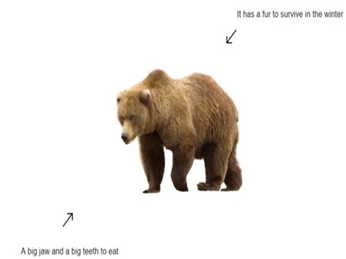
Animals hibernate in order to survive from the winter, and for safety from predators. -Hinata

Some animals’ eyes like lions, dogs, wolves, tigers, cats, and bears are like people’s eyes, which are looking at the same place, while some animals like horses and deer have eyes that can see two sides. These can help them run away from meat-eating animals. – Anqqing
B. Students reflected on the following Key Concepts: Why do organisms (plants and animals) need to adapt?
| In order to survive, all organisms must adapt to their habitat. This will require adaptation to enable ecosystems, predators, and other species competing for much the same space and nutrients to stay alive. – Monica | Organisms need to adapt because at times their surroundings don’t fit their traits and if they don’t change they might die. So after a few generations they change. Like how giraffes have long necks to be able to eat leaves. – Nino |
| Because they need to live in the world, if they don’t adapt, they will die. – Angqing | They need to adapt so they can be safe from predators. – JP |
| So that they could survive and make the environment convenient and comfortable. The predators need to be sneaky to eat the prey. The prey also need to adapt to survive. – Hinata | Organisms need to adapt so that they can survive in their environment. There are different adaptations in the animal’s life. It takes a long time to do adaptations. Giraffes needed to stretch a lot for a long time to make their neck long. Now, the giraffes are able to get food more easily from the trees around them because they have long necks. – Saki |
C. Why do animals migrate?
| Most animals either migrate to find food or to find an appropriate place to raise their young. The realization there are far less predators and less competitors in the UK from other species than in warmer, southwest countries is used by Spring and Summer migrants. – Monica | Animals migrate so that they can find food or a good place to breed and raise their babies. It would also help the animal to survive. Migrating has some risk but animals need to migrate that way to survive. Sometimes, animals migrate depending on the seasons. – Saki |
| Animals migrate because the weather doesn’t suit their survival needs. So instead of adapting they decide to move to a place with a different weather. Like how birds migrate when winter comes. – Nino | Because maybe all the food there is gone or maybe because their habitat is on fire or there is something there that they need but it is not there anymore. – Jacob |
| Most animals migrate in the winter to tropical climates or sunny places because they are not suitable for cold weather. Some animals also migrate to breed with their mates. – Chloe | To find a rich place and the weather. – Angqing
|
D. Why do animals hibernate?
| During the winter, the animal has significantly slowed body temperature, heart rate, respiration, and other metabolic activities to conserve energy. Hibernation permits animals such as bears and sparrows to use energy much slower while the reserves are scarce. – Monica | Animals like bears hibernate. Similarly to migrating the weather doesn’t fit their needs. But instead of going somewhere else, they eat lots of food and sleep through winter. – Nino |
| When animals hibernate, the body temperature, and other body activities slow down to save energy. – Jeonghoo | |
All of these concepts have been reinforced through a virtual simulation called Build A Bird, where students were able to select adaptive features for their own bird. Students were able to create and measure their own “assemblage“ of adaptive features for their bird suitable for their chosen habitat.
So timely and relevant, as we are currently facing this unprecedented trying time due to the COVID-19 pandemic, our way of adaptation in learning has also been tested. And when these groups of students were asked:
How well have you adapted to this “New Normal” of LEARNING?
Here’s what they had to say.
| I think I will rate myself 100%. I have understood the idea that it is important for everyone to stay at their home in this situation to keep everyone safe. I am now well used to doing homework online, sending messages online, and having lessons online with my classmates. I think I adapted so well that I always have my devices with me. – Saki | I will rate myself 100%. I rate myself 100 because I feel like over the past time I have adapted to this new lifestyle for almost a year now and I have gotten used to it. I even changed my sleep schedule. I have already gotten used to how we do the homework and class work virtually. Therefore, I think that remote learning is an ideal way to do learning while staying at your home during this pandemic. Monica |
| I will rate myself a 98%. I rate myself 98 because I feel like I have adapted to this lifestyle of staying home and online learning. I also understand that we have to stay home to stay safe. But I also want to go out sometimes and wish that the pandemic was over and we could go back to face to face learning. – Chloe | I rate myself 99% because I have completely adapted myself to remote learning. I can use the internet and some devices well. I also adapted to learn virtually. But I still have a feeling that I want to do Face-To-Face class since it is easier to communicate with teachers and friends. – Hana |
| I rate myself 70%, because for me, I think I’m bored, and I did not learn much things, so I think it is bad for me to have an e-learning too long. – Angqing | I will rate myself 60% because I typed the details and the information from the research. I was able to know a little bit of writing details and I also learned about researching. Researching is a hard thing to do but I was able to accomplish it. My weakness was that the details and the vocab were not in my mind so i wasn’t able to accomplish that. -Hinata |
| I will rate myself 85% because I write in detail as I can, and I was able to learn new things. I learn many things in the gadget I didn’t know, like the systems in google doc, google slide, google classroom, etc. I think I adapt well in using the device. – Jeonghoo | I think I have done it 90% because It was a bit hard for me to learn how to use google classroom. But the good thing is that I don’t need to drive to school and I get to sleep in for a bit and we can go out but we need a mask to go out and the classes are shorter but then if I need help with something, it’s more hard because I can’t just go up to a teacher and ask for help. -Jacob |
| I rate myself 100% because I have worked well with online classes and also know it is not safe yet to have face to face school. I have adapted very well with my environment because it is home as well as playing with my pets a lot. – John | I think I would rate myself a 100% I was able to learn new information like I always do. I have learned how to use gadgets and software like google classroom, google meets, etc. I am able to do homework, send messages for help, and be on time for class. I think that I have adapted very well that I usually keep my devices with me. – Nino |
Grade 7 Science
It has been almost a year since CIS began conducting Remote Learning due to lockdowns and quarantine implementation. If there is one thing that the national lockdowns have done to universally benefit all creatures on Earth, it is the provision of a better air quality to people and of course to all diverse life forms. According to Neill (2020), “Air pollution is a major driving force changing the natural environment. It is changing the basic structure and function of ecosystems, thus affecting biodiversity”. This is very logical indeed, because since quarantine protocols have been implemented, people’s movement has been restricted, thus limiting the vehicles running in the streets, and minimizing industries from burning fuels as they limit production (which is also sad to note).
Plant and animal species are disappearing at an ever faster rate due to human activity. What are the causes and why does biodiversity matter? Biodiversity, or the variety of all living things on our planet, has been declining at an alarming rate in recent years, mainly due to human activities, such as land use changes, pollution (air, water, soil, land, and noise) and climate change (News European Parliament, 2020). Humans create a great impact on biodiversity.
Who says the Grade 7 students did not realize this? Here is what they have to say about Biodiversity through posters they created, as well as its status and what we can possibly do to help save it from getting to its worse state:
 In my poster I included what biodiversity was for me. I think biodiversity is learning to be equal no matter who or what or how we identify. No matter the color of our skin or who we love. I also included that we must consider plants and organisms as our own, we are hurting mother earth and must stop it; I included ways to reduce pollution in my poster. – Aadya
In my poster I included what biodiversity was for me. I think biodiversity is learning to be equal no matter who or what or how we identify. No matter the color of our skin or who we love. I also included that we must consider plants and organisms as our own, we are hurting mother earth and must stop it; I included ways to reduce pollution in my poster. – Aadya
 I made a poster about biodiversity. I have three questions in the poster and I also answered the questions. The picture in the middle I put some endangered animals such as a tiger, panda, polar bears, sea turtles, and a tarsier. I expressed the earth in the bottom part and on the top part of the earth drawing, I drew their habitats like an ice bear lives in the ice and the panda lives in a bamboo forest, a tiger usually lives in mountains, and lastly the sea turtle lives in the sea. The meaning of my drawing there is that every animal in this world has to be protected in their habitat and people should no longer harm nature. – Chaewon
I made a poster about biodiversity. I have three questions in the poster and I also answered the questions. The picture in the middle I put some endangered animals such as a tiger, panda, polar bears, sea turtles, and a tarsier. I expressed the earth in the bottom part and on the top part of the earth drawing, I drew their habitats like an ice bear lives in the ice and the panda lives in a bamboo forest, a tiger usually lives in mountains, and lastly the sea turtle lives in the sea. The meaning of my drawing there is that every animal in this world has to be protected in their habitat and people should no longer harm nature. – Chaewon
 – Haylee
– Haylee
 In my poster, I wrote about what biodiversity meant in my perspective and what is going on in our world right now that is related to biodiversity. The current status of biodiversity is also explained on my poster; talking about certain actions that happen which are harmful to our environment, ecosystems, and many species that are alive. I then listed a few ideas about what we can do in our day to day lives to help; even if it’s just by a little. I believe that, despite all the harm already inflicted, if people put in minimal effort together to help; there can be a change. – Yi Chen
In my poster, I wrote about what biodiversity meant in my perspective and what is going on in our world right now that is related to biodiversity. The current status of biodiversity is also explained on my poster; talking about certain actions that happen which are harmful to our environment, ecosystems, and many species that are alive. I then listed a few ideas about what we can do in our day to day lives to help; even if it’s just by a little. I believe that, despite all the harm already inflicted, if people put in minimal effort together to help; there can be a change. – Yi Chen
 The first drawing is an example of Biodiversity; it is a drawing of flowers and trees. The second one is a picture of a man cutting trees. It is to show the status of Biodiversity. I can help save Biodiversity by planting trees and simple acts such as helping keep the environment clean. – Ryota
The first drawing is an example of Biodiversity; it is a drawing of flowers and trees. The second one is a picture of a man cutting trees. It is to show the status of Biodiversity. I can help save Biodiversity by planting trees and simple acts such as helping keep the environment clean. – Ryota
 – Seyoung
– Seyoung
 This poster is all about biodiversity, its current state, and what we can do to help. I decided to go for more of a visual poster than a wordy one. I included 2 Earths: one with a healthy biodiverse ecosystem, and the other a completely destroyed one. I decided to go for the more visual approach because I want to capture the attention of people such as you reading this. This topic is very personal to me because I am a very animal-plant-outdoor loving kind of person. Knowing that we Homo sapiens, being the cause of destruction of biodiversity, makes me sad. -Amelia
This poster is all about biodiversity, its current state, and what we can do to help. I decided to go for more of a visual poster than a wordy one. I included 2 Earths: one with a healthy biodiverse ecosystem, and the other a completely destroyed one. I decided to go for the more visual approach because I want to capture the attention of people such as you reading this. This topic is very personal to me because I am a very animal-plant-outdoor loving kind of person. Knowing that we Homo sapiens, being the cause of destruction of biodiversity, makes me sad. -Amelia
 In my poster I explained what Biodiversity means to me and the meaning of biodiversity in my own words. In my opinion, I think Biodiversity is a very usual thing like organizing the animals and natural living, it could organize them in each group to make it look clear and organized. I am saying that we are all connected. – Taeung
In my poster I explained what Biodiversity means to me and the meaning of biodiversity in my own words. In my opinion, I think Biodiversity is a very usual thing like organizing the animals and natural living, it could organize them in each group to make it look clear and organized. I am saying that we are all connected. – Taeung
 – Grace
– Grace
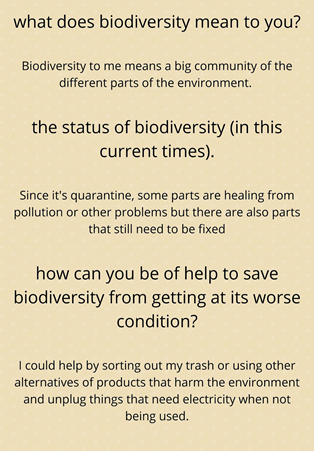 My answers are based on what I’ve seen. There have been comparisons between cities before and after there was quarantine. The photos after quarantine are the ones that look less polluted. Climate change is something that needs to be taken care of and the use of electricity causes greenhouse gases to be emitted. Air pollution is a common type of pollution, and so is water pollution. Trash that doesn’t biodegrade can last for a long time. Sometimes animals will think that trash is their prey or source of food and eat it which harms them. – Kasey
My answers are based on what I’ve seen. There have been comparisons between cities before and after there was quarantine. The photos after quarantine are the ones that look less polluted. Climate change is something that needs to be taken care of and the use of electricity causes greenhouse gases to be emitted. Air pollution is a common type of pollution, and so is water pollution. Trash that doesn’t biodegrade can last for a long time. Sometimes animals will think that trash is their prey or source of food and eat it which harms them. – Kasey
 – Asahi
– Asahi
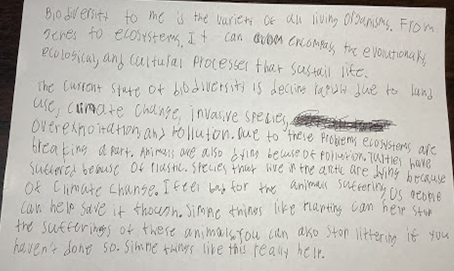 In the poster, I talked about what biodiversity is for me. I also talked about the current state of biodiversity and how it is not in a very good state. I talked about how animals in the Arctic and sea creatures are suffering because of climate change and pollution. I also talked about how we can help save biodiversity. I gave suggestions like planting. which can help attract birds and wildlife, purify our air, prevent soil erosion, clean our water, and add grace and beauty to our homes and communities. I also said that you can stop littering because it can help stop global warming. – Xavier
In the poster, I talked about what biodiversity is for me. I also talked about the current state of biodiversity and how it is not in a very good state. I talked about how animals in the Arctic and sea creatures are suffering because of climate change and pollution. I also talked about how we can help save biodiversity. I gave suggestions like planting. which can help attract birds and wildlife, purify our air, prevent soil erosion, clean our water, and add grace and beauty to our homes and communities. I also said that you can stop littering because it can help stop global warming. – Xavier
Neill, P. (2020). The crucial link between air pollution and biodiversity loss – Air Quality News.
Retrieved 17 February 2021, from https://airqualitynews.com/2020/07/03/the-crucial-link-between-air-pollution-and-biodiversity-loss/
Biodiversity Loss: what is causing it and why is it a concern? | News | European Parliament. (2020).
Retrieved 17 February 2021, from https://www.europarl.europa.eu/news/en/head lines/society/20200109STO69929/biodiversity-loss-what-is-causing-it-and-why-is-it-a-concern
College/Careers Counselor Corner
by Ms. Jenny Basa, College/Careers Counselor
Tip of the Week:
Universities are interested in your extracurricular involvement from Grade 9-12. This is organized in a resume’ or curriculum vitae (CV). When arranging your activities, work experience, honors and awards, always start with the most recent. Include the following details: Name of activity, your role, brief description, length of time allotted to the activity, dates and keep a copy of pictures if you have any. These photos can be used in your CAS portfolio in Grade 11 and 12 or on a website you may want to create for your activities in high school.
Virtual Alumni Chat Series
SAT Update
March 13 SAT test date has been cancelled.

Students are advised to check the university websites for Test-optional announcements.
| 2020-2021 Test Dates | Test | Registration Deadline |
| March 13, 2021 | SAT only (no Subject tests) | Cancelled |
| May 8, 2021 | SAT & SAT Subject Tests | April 8, 2021 |
| June 5, 2021 | SAT & SAT Subject Tests | May 6, 2021 |
To register for the SAT, you may click on this link. If you need assistance or have any questions, please feel free to email Ms. Jenny Basa at jbasa@cis.edu.ph.





